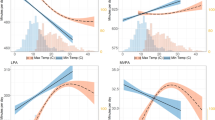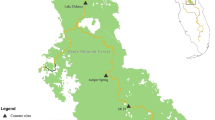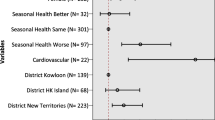Abstract
The aim of this study was to investigate the impact of daily atmospheric weather conditions on daily leisure activity engagement, with a focus on physically active leisure. The methods capitalize on time diary data that were collected in Halifax, Nova Scotia to calculate objective measures of leisure activity engagement. Daily meteorological data from Environment Canada and daily sunrise and sunset times from the National Research Council of Canada are used to develop objective measures of the natural atmospheric environment. The time diary data were merged with the meteorological data in order to quantify the statistical association between daily weather conditions and the type, participation rate, frequency, and duration of leisure activity engagement. The results indicate that inclement and uncomfortable weather conditions, especially relating to thermal comfort and mechanical comfort, pose barriers to physically active leisure engagement, while promoting sedentary and home-based leisure activities. Overall, daily weather conditions exhibit modest, but significant, effects on leisure activity engagement; the strongest associations being for outdoor active sports and outdoor active leisure time budgets. In conclusion, weather conditions influence the type, participation rate, frequency, and duration of leisure activity engagement, which is an important consideration for health-promotion programming.
Similar content being viewed by others
Notes
Coaching has been included within the civic and voluntary category due to a low frequency of activity episodes (n=25).
“Outdoors away from home” is one of the location codes used to select active sports that occurred in outdoor locations (e.g. soccer field, baseball diamond). Fortunately, the time diary survey also captured text descriptions of location, because “other place” was used to represent many indoor and outdoor locations, such as parks and sports fields.
References
Andrey J, Knapper CK (eds) (2003) Weather and Transportation. Department of Geography Publication Series #55, University of Waterloo
Ås D (1978) Studies of time-use: problems and prospects. Acta Sociol 21:125–141
Ås D (1982) Designs for large scale time use studies of the 24 hour day. In: Staikev Z (ed) Its about time: Proceedings of the International Research Group on time budgets and social activities. Sofia, Bulgaria, pp 17–53
Baranowski T, Thompson WO, DuRant RH, Baranoswki J, Puhl J (1993) Observations on physical activity in physical locations: age, gender, ethnicity and month effects. Res Q Exerc Sport 64:127–133
Bélanger M, Gray-Donald K, O’Loughlin J, Paradis G, Hanley J (2009) Influence of weather conditions and season on physical activity in adolescents. Ann Epidemiol 19:180–186
Bélanger-Ducharme F, Tremblay A (2005) Prevalence of obesity in Canada. Obes Rev 6:183–186
Bittman M (2002) Social participation and family welfare: the money and time costs of leisure in Australia. Soc Policy Admin 36:408–425
Bricka S (2008) Non-Response Challenges in GPS-based Surveys, Resource Paper Prepared for the May 2008 International Steering Committee on Travel Survey Conferences Workshop on Non-Response Challenges in GPS-based Surveys. Retrieved from http://www.nustats.com/nustats_dot_com/templates/yet_again_new-menu/docs/great_reads/Nonresponse_GPS_BasedSurveys.pdf
Cameron C, Wolfe R, Craig C (2007) Physical activity and sport: Encouraging children to be active. In: Physical Activity Monitor Ottawa, ON: Canadian Fitness and Lifestyle Research Institute. Retrieved from http://www.cflri.ca/eng/statistics/surveys/documents/PAM2005.pdf
Cerin E, Vandelanotte C, Leslie E, Merom D (2008) Recreational facilities and leisure-time physical activity: an analysis of moderators and self-efficacy as a mediator. Health Psychol 27(Suppl 1):S126–S135
Chan CB, Ryan DA (2009) Assessing the effects of weather conditions on physical activity participation using objective measures. Int J Environ Res Public Health 6:2639–2654
Chan CB, Ryan DA, Tudor-Locke C (2006) Relationship between objective measures of physical activity and weather: a longitudinal study. Int J Behav Nutr Phy 3. Retrieved from http://www.ijbnpa.org/content/3/1/21
Contoyannis P, Wildman J (2007) Using relative distributions to investigate the body mass index in England and Canada. Health Econ 16:929–944
Converse PE (1968) Time budgets. In: Sills D (ed) International encyclopedia of the social sciences 16. Crowell, Collier, and Macmillan, New York, pp 42–47
Dishman RK, Sallis JF (1994) Determinants and interventions for physical activity and exercise. In: Bouchard C, Shephard RJ, Stephens T (eds) Physical activity, fitness, and health: International proceedings and consensus statement. Human Kinetics, Champaign, IL, pp 214–238
Dishman RK, Sallis JF, Orenstein DR (1985) The determinants of physical activity and exercise. Public Health Rep 100:158–171
Duxbury L, Higgins C, Coghill D (2003) Voices of Canadians: seeking work-life balance. Human Resources Development Canada, Labour Program, Ottawa, ON
Eisenberg D (2004) The mixed effects of precipitation on traffic crashes. Accid Anal Prev 36:637–647
Giles-Corti B, Donovan RJ (2002) The relative influence of individual, social and physical environment determinants of physical activity. Soc Sci Med 54:1793–1812
Gilliland J, Holmes M, Tucker P, Irwin J (2006) Environmental equity is child’s play: mapping provision of public recreation spaces in urban neighbourhoods. Vulnerable Children and Youth Studies 1:256–268
Gordon-Larsen P, McMurray RG, Popkin BM (2000) Determinants of adolescent physical activity and inactivity patterns. Pediatrics 105. Retrieved from http://pediatrics.aappublications.org/cgi/content/full/105/6/e83
Gordon-Larsen P, Nelson MC, Page P, Popkin BM (2006) Inequality in the built environment underlies key health disparities in physical activity and obesity. Pediatrics 117:417–424
Harvey AS (1990) Time use studies for leisure analysis. Soc Indic Res 23:309–336
Harvey AS (1993) Guidelines for time use data collection. Soc Indic Res 30:197–228
Hewitt K, Burton I (1971) The hazardousness of a place: a regional ecology of damaging events. University of Toronto Press, Toronto
Humbert ML, Chad KE, Spink KS, Muhajarine N, Anderson KD, Bruner MW, Girolami TM, Odnokon P, Gryba CR (2006) Factors that influence physical activity participation among high- and low-SES youth. Qual Health Res 16:467–483
Humpel N, Owen N, Leslie E (2002) Environmental factors associated with adults’ participation in physical activity: a review. Am J Prev Med 22:188–199
Ifedi F (2005) Sport participation in Canada, 2005. Ottawa, ON: Statistics Canada. Retrieved from http://www.statcan.gc.ca/pub/81-595-m/81-595-m2008060-eng.pdf
Juster F, Stafford F (1991) The allocation of time: empirical findings, behavior models, and problems of measurement. J Econ Lit 29:471–522
Katzmarzyk PT, Janssen I (2004) The economic costs associated with physical inactivity and obesity in Canada: an update. Can J Appl Physiol 29:90–115
Katzmarzyk P, Mason C (2006) Prevalence of class I, II and III obesity in Canada. Can Med Assoc J 174:156–157
Katzmarzyk PT, Tremblay MS (2007) Limitations of Canada’s physical activity data: implications for monitoring trends. Appl Physiol Nutr Me 32(Suppl 2E):S185–S194
King AC, Blair SN, Bild DE, Dishman RK, Dubbert PM, Marcus BH, Oldridge NB, Paffenbarger RS Jr, Powell KE, Yeager KK (1992) Determinants of physical activity and interventions in adults. Med Sci Sport Exer 24(Suppl 6):S221–S236
King AC, Castro CM, Wilcox S, Eyler AA, Sallis JF, Brownson R (2000) Personal and environmental factors associated with physical inactivity among different racial-ethnic groups of US middle-aged and older-aged women. Health Psychol 19:354–365
Laird-Birmingham C, Nuller J, Palepu A, Spinelli J, Anis A (1999) The cost of obesity in Canada. Can Med Assoc J 160:483–488
Lin Q, Nixon W (2008) Effects of adverse weather on traffic crashes: systematic review and meta-analysis. In: Proceedings of the 87nd annual meeting of the Transportation Research Board CDROM. Transportation Research Board of the National Academies: Washington DC
Lindsey G, Han Y, Wilson J, Yang J (2006) Neighborhood correlates of urban trail use. J Phys Act Health 3(Suppl 1):S139–S157
Mäkinen TM, Raatikka V-P, Rytkönen M, Jokelainen J, Rintamäki H, Ruuhela R, Näyhä S, Hassi J (2006) Factors affecting outdoor exposure in winter: population-based study. Int J Biometeorol 51:27–36
Matthews CE, Freedson PS, Hebert JR, Stanek EJ, Merriam PA, Rosal MC, Ebbeling C, Ockene I (2001) Seasonal variation in household, occupational, and leisure time physical activity: longitudinal analyses from the seasonal variation of blood cholesterol study. Am J Epidemiol 153:172–183
McGinn AP, Evenson KR, Herring AH, Huston SL (2007) The relationship between leisure, walking, and transportation activity with the natural environment. Health Place 13:588–602
Merchant AT, Dehghan M, Akhtar-Danesh N (2007) Seasonal variation in leisure time physical activity among Canadians. Can J Public Health 98:203–208
Merrill RM, Shields EC, White GL, Druce D (2005) Climate conditions and physical activity in the United States. Am J Health Behav 29:371–381
Michelson W (2005) Time use: expanding the explanatory power of the social sciences. Paradigm, London
Oliveira S, Andrade H (2007) An initial assessment of the bioclimatic comfort in an outdoor public space in Lisbon. Int J Biometeorol 52:69–84
Panter JR, Jones AP (2008) Associations between physical activity, perceptions of the neighbourhood environment and access to facilities in an English city. Soc Sci Med 67:1917–1923
Riva M, Gauvin L, Richard L (2007) Use of local area facilities for involvement in physical activity in Canada: insights for developing environmental and policy interventions. Health Promot Int 22:227–235
Robinson JP, Godbey G (1999) Time for life: the surprising ways Americans use their time. Pennsylvania State University Press, University Park
Sallis JF, Hovell MF, Hofstetter CR, Faucher P, Elder JP, Blanchard J, Caspersen CJ, Powell KE, Christenson GM (1989) A multivariate study of determinants of vigorous exercise in a community sample. Prev Med 18:20–34
Sallis JF, Hovell MF, Hofsetter CR, Elder JP, Hackley M, Casperson CJ (1990) Distance between homes and exercise facilities related to frequency of exercise among San Diego residents. Public Health Rep 105:179–185
Sallis JF, Bauman A, Pratt M (1998) Environmental and policy interventions to promote physical activity. Am J Prev Med 15:379–397
Salmon J, Owen N, Crawford D, Bauman A, Sallis JF (2003) Physical activity and sedentary behavior: a population-based study of barriers, enjoyment, and preference. Health Psychol 22:178–188
Spinney J (2007) The Halifax Space Time Activity Research (STAR) Project: Spatio-Temporal Opportunities for Public Health Research. Mapping Health Geography in Nova Scotia. Retrieved from http://www.nshrf.ca/Download.aspx?serverfn=./files/drm/0819a66e-4f6a-4676-ab86-15a95a80ce5b.pdf&downloadfn=Panel-HealthPolicy_Planning.pdf&contenttype=
Spinney JEL, Scott DM, Newbold KB (2009) Transport mobility benefits and quality of life: a time-use perspective of elderly Canadians. Transport Policy 16:1–11
Statistics Canada (2005) General Social Survey on time use, overview of time use of Canadians, 2005. (Catalogue no 12F0080-XIE). Retrieved from http://www.statcan.gc.ca/pub/12f0080x/12f0080x2006001-eng.pdf
Statistics Canada (2006) General Social Survey - Cycle 19: time use (2005) user’s guide to the public use microdata file. Ottawa, Statistics Canada
Suminski R, Poston W, Market P, Hyder M, Sara P (2008) Meteorological conditions are associated with physical activities performed in open-air settings. Int J Biometeorol 52:189–197
Sumukadas D, Witham M, Struthers A, McMurdo M (2009) Day length and weather conditions profoundly affect physical activity levels in older functionally impaired people. J Epidemiol Commun Health 63:305–309
Togo F, Watanabe E, Park H, Shephard RJ, Aoyagi Y (2005) Meteorology and the physical activity of the elderly: the Nakanojo Study. Int J Biometeorol 50:83–89
Tremblay MS, Shephard RJ, McKenzie TL, Gledhill N (2001) Physical activity assessment options within the context of the Canadian Physical Activity, Fitness, and Lifestyle Appraisal. Can J Appl Physiol 26:388–407
Tremblay M, Katzmarzyk P, Willms J (2002) Temporal trends in overweight and obesity in Canada, 1981–1996. Int J Obes 26:538–543
Tu W, Stump TE, Damush TM, Clark DO (2004) The effects of health and environment on exercise-class participation in older, urban women. J Aging Phys Activ 12:480–496
Tucker P, Gilliland J (2007) The effect of season and weather on physical activity: a systematic review. Public Health 121:909–922
Tudor-Locke C, Bassett DR, Swartz AM, Strath SJ, Parr BB, Reis JP, Dubose KD, Ainsworth BE (2004) A preliminary study of one year of pedometer self-monitoring. Ann Behav Med 28:158–162
Tudor-Locke C, Bittman M, Merom D, Bauman A (2005) Patterns of walking for transport and exercise: a novel application of time use data. Int J Behav Nutr Phy 2:1–10
TURP (2008a) Halifax Regional Space Time Activity Research (STAR) Survey: survey DESIGN. Saint Mary’s University, Time Use Research Program, Halifax
TURP (2008b) Halifax Regional Space Time Activity Research (STAR) Survey: sampling strategy. Saint Mary’s University, Time Use Research Program, Halifax
Von Mackensen S, Hoeppe P, Maarouf A, Tourigny P, Nowak D (2005) Prevalence of weather sensitivity in German and Canada. Int J Biometeorol 49:156–166
Wilcox S, Castro C, King AC, Housemann R, Brownson RC (2000) Determinants of leisure time physical activity in rural compared with urban older and ethnically diverse women in the United States. J Epidemiol Commun Health 54:667–672
Yusuf HR, Croft JB, Giles WH, Anda RF, Casper ML, Caspersen CJ, Jones DA (1996) Leisure-time physical activity among older adults United States, 1990. Arch Intern Med 156:1321–1326
Author information
Authors and Affiliations
Corresponding author
Rights and permissions
About this article
Cite this article
Spinney, J.E.L., Millward, H. Weather impacts on leisure activities in Halifax, Nova Scotia. Int J Biometeorol 55, 133–145 (2011). https://doi.org/10.1007/s00484-010-0319-z
Received:
Revised:
Accepted:
Published:
Issue Date:
DOI: https://doi.org/10.1007/s00484-010-0319-z




